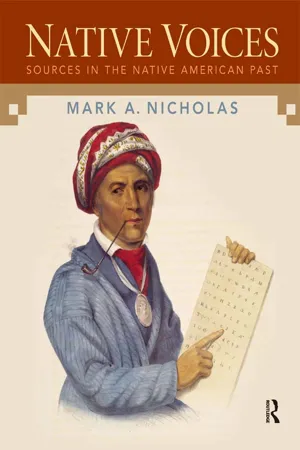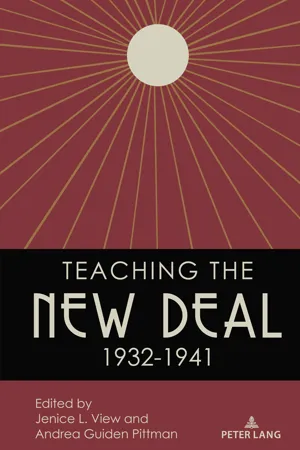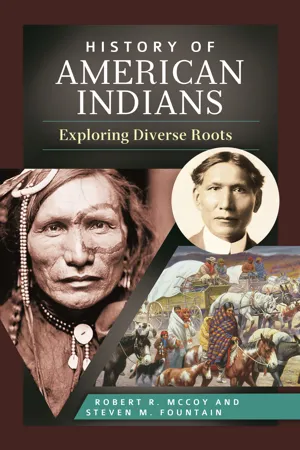History
Native Americans and the New Deal
The New Deal, a series of economic and social reforms implemented by President Franklin D. Roosevelt in the 1930s, had a significant impact on Native American communities. The Indian Reorganization Act of 1934 aimed to reverse the detrimental policies of assimilation and land loss, promoting tribal self-governance and cultural preservation. While it faced criticism and varied implementation, the New Deal marked a shift towards recognizing Native American sovereignty and rights.
Written by Perlego with AI-assistance
Related key terms
1 of 5
7 Key excerpts on "Native Americans and the New Deal"
- eBook - ePub
Native Voices
Sources in the Native American Past, Volumes 1-2
- Mark A Nicholas, Mark Nicholas(Authors)
- 2016(Publication Date)
- Routledge(Publisher)
HAPTER 10NATIVE AMERICANS , THE GREAT DEPRESSION , AND WORLD WAR II, AND THE REORGANIZATION OF INDIAN COUNTRY , 1930–1950CHAPTER OUTLINE▪Introduction▪The Indian New Deal▪World War II▪Termination and Relocation and the Emergence of a New Native American ActivismINTRODUCTION
The 1920s and 1930s were decades of tremendous upheaval for native peoples. The Great Depression, which afflicted all Americans, for Native Americans resulted in the loss of any on- or off-reservation jobs; falling land, crop, cattle, and oil prices that had brought in a windfall of profits for some reservation communities since the Dawes Act; and debilitated sales of native peoples’ arts and crafts once the depression years obliterated America’s economy of touring areas known for fine native wares such as the southwest. Unsanitary living conditions and alcoholism accompanying poverty and desperation crushed reservation communities and families. By the late 1920s, tribal communities looked to state and federal officials to help pull them out of an economic crisis that seemed to have no end. Strained financially, state and federal policymakers put most of their resources into urban centers. Native Americans, it seemed, would weather the Great Depression alone and isolated from any government support. President Franklin Delano Roosevelt tried to ensure that Native Americans would survive and gave John Collier, the commissioner of Indian Affairs during the Roosevelt administration, wide latitude in helping Indians. Collier’s “Indian New Deal” created jobs, protected Native American arts and crafts so communities could generate profits, and worked to help Indians manage reservation resources to better their communities. Some of Collier’s programs were more successful than others, largely because Collier, who had spent considerable time in the southwest, tried to apply one blueprint of change to all Native Americans that did not necessarily work because of the cultural and linguistic diversity in Indian Country. - Available until 23 Dec |Learn more
An Alaska Anthology
Interpreting the Past
- Stephen W. Haycox, Mary Childers Mangusso, Stephen W. Haycox, Mary Childers Mangusso(Authors)
- 2011(Publication Date)
- University of Washington Press(Publisher)
Collier believed that the Dawes Act and similar efforts had led to poverty, landlessness, and the general social disorientation of Native Americans. Shortly after taking office, he met with officials in the Department of the Interior and formulated a new federal Indian policy based on the concept of cultural pluralism. The centerpiece of this policy—the Indian New Deal—was the Indian Reorganization Act of 1934, which encouraged the use of reservations as homelands where tribes could engage in self-government and cooperative economic activity. 2 Historians have recently provided new insights concerning the Indian New Deal, but they have neglected to analyze carefully how it affected the Eskimos, Aleuts, and Indians who resided in the territory of Alaska. 3 The Alaska Reorganization Act of 1936 allowed Natives to establish village self-government and borrow money from a federal credit fund in order to combat the effects of the Great Depression. 4 The Interior Department used this legislation to create five reservations, and it held hearings to determine the extent of Haida and Tlingit claims to fishing rights and land in southeastern Alaska. The Alaska Reorganization Act provided the Natives with needed financial assistance, but it was poorly administered and inadequately funded by Congress. More important, the policy of setting aside reservations met opposition from white settlers and Natives who had become assimilated after Alaska came under the jurisdiction of the United States in 1867. 5 Rather than listen to their critics, New Deal officials in the Interior Department pushed ahead with plans to establish reservations and determine the validity of Native claims. They neglected, however, to consult with Congress or gain needed grass-roots support - eBook - PDF
- Jenice View, Andrea Guiden Pittman, James Mitchell, Charlotte L. Johnson, Erik Alexander, Caroline R. Pryor, Michael E. Karpyn, Jenice View(Authors)
- 2021(Publication Date)
C H A P T E R T W O Teaching the Indian New Deal JOHN R. GRAM The Bureau of Indian Affairs released the following order to its employees in 1934: No interference with Indian religious life will be hereafter tolerated, The cultural history of Indians is in all respects to be considered equal to that of any non-Indian group, And it is desirable that Indians be bilingual—fluent and literate in English, and fluent in their vital, beautiful, and efficient native languages. (Iverson & Davies, 2015, p. 87) The shock of this statement in its historical context is muted by our commitment to cultural pluralism and cultural relativism as a society in the early twenty-first century. 1 However, in 1934, it was nothing less than revolutionary—a radical break with federal policy toward American Indians over the previous half-century. Like many other impoverished or rural communities, American Indian tribes benefited from multiple New Deal programs. American Indians found employ- ment with the Civilian Conservation Corps, though they formed a separate branch of the Corps, known as the Indian Emergency Conservation Work pro- gram (later, the Civilian Conservation Corps-Indian Division), the Public Works Administration built schools and other public buildings on reservations, and American Indian artists received funding through the Works Progress Admin- istration. This chapter, however, will focus on the significant changes in the rela- tionship between the federal government and tribal nations collectively known as the “Indian New Deal.” 20 | JOHN R . GRAM One of the difficulties in teaching the Indian New Deal is that, depending on the curriculum being used, American Indians probably have not been on students’ radar for almost fifty years since the end of the “Indian Wars” in the American West. Yet, the Indian New Deal was a conscious (if not necessarily complete) rejection of much of what had taken place during these five decades. - eBook - ePub
Dismembered
Native Disenrollment and the Battle for Human Rights
- David E. Wilkins, Shelly Hulse Wilkins(Authors)
- 2017(Publication Date)
- University of Washington Press(Publisher)
As late as the early 1930s, the incredible diversity evident in Indigenous governing structures, along with the value systems that underlay them, indicated that Native peoples were willing to embrace new legal and political mechanisms in an effort to adjust to the ever shifting landscape they lived in. Simultaneously, varying segments of many Native nations strove and had some success in maintaining precontact sociocultural norms, institutions, and traditions to distinguish themselves from other nations and several intruding political powers they had to contend with. Even in the most intensely divided nations, the vying groups sometimes still based their political, economic, and citizen decisions upon traditional beliefs, structures, and leadership styles that were deeply rooted in historic arrangements that predated the arrival of non-Indians on their lands.Documentation of who belonged in tribal nations came from a variety of sources in the years leading up to the IRA. First, many Native peoples had signed treaties and were required to sign up to receive annuities. Second, some Native nations had formal rolls established for them, like the ones prepared by the Dawes Commission members for the Five Civilized Tribes. In other cases tribal members’ names appeared on specific Indian census rolls that were gathered beginning in the 1880s by superintendents or agents. At the same time, some Native individuals’ names appeared on federal census records that, beginning in the latter part of the nineteenth century, did a special enumeration of Natives on specific reservations.Thus, by the time Franklin D. Roosevelt became president in 1933, signaling the start of the so-called Indian New Deal, there were several documentary record sets—none of which was without flaws and errors—available to both tribal and federal officials that enabled both sets of governing bodies to identify who was an enrolled Native citizen. These records provide the documentary baseline that federal policymakers and tribal leaders would come to rely on, beginning with adoption of the IRA, once it was enacted in 1934, and continuing to the present time.NEW DEAL FOR NEW TIMESThe New Deal of Franklin D. Roosevelt brought radical changes for many Native nations. John Collier, Roosevelt’s commissioner of Indian affairs, was an energetic and idealistic social scientist who understood non-Western cultures better than any of his predecessors. To assist Native nations in the stabilization and reconstitution of their political bases and to help them revitalize their cultural traditions, Collier, with the considerable help of Felix S. Cohen, introduced the IRA in 1934.4 Although Congress amended and dramatically reduced the breadth of the bill at the insistence of various sources, including “the fears of individual Indians owning allotments, the interests of non-Indian groups leasing Indian land using Indian timber, the concerns of missionary groups operating on Indian reservations, and congressional beliefs about the appropriate relationship between Indians and the federal government,” basic redefinition of critical concepts produced additional changes in indigenous status.5 - eBook - ePub
History of American Indians
Exploring Diverse Roots
- Robert R. McCoy, Steven M. Fountain(Authors)
- 2017(Publication Date)
- Greenwood(Publisher)
The Indian New Deal and World War II, 1924–1945
REFORMING INDIAN COUNTRY
Life for most tribal communities in the United States during the first two decades of the twentieth century was punctuated by loss of land, assaults on their culture, and increasing pressure to assimilate. Despite these pressures, Indian people resisted land loss, organized local, regional, and national organizations to advocate for their rights, and sought to continue their cultural and spiritual life the best way they could. In the 1920s, the decade-long effects of allotment, boarding schools, and poor health conditions on reservations began to gain public attention.Throughout the western United States, tribal communities coped with the exploitation of their natural resources and their land. On reservations that had been allotted, Indian landholdings were interspersed with nonnative land, and many people lost their land to bad business deals, inability to pay taxes, or simply selling land to pay for expenses. Along with the loss of land, Indian communities dealt with the exploitation of natural resources, including water, oil and gas, timber, and other minerals. Miners trespassed on Indian land and placed mineral claims on tribal land. In Oklahoma, the secretary of the interior began issuing oil and gas leases and unleashed a cycle of exploitation that bilked enormous amounts of money out of tribes. On many reservations, the Bureau of Indian Affairs worked with local ranchers and farmers to take advantage of water and grazing rights on Indian land, often leaving these parcels unfit for cultivation. All of these abuses took place in the climate of legal and bureaucratic decisions that reinforced the ability of the federal government and its representatives to make decisions for Indians without their input or permission. The trust and guardianship relationship led to enormous corruption and abuse that would not be fully addressed by the federal government until the beginning of the twenty-first century. - eBook - PDF
Native America
A History
- Michael Leroy Oberg(Author)
- 2015(Publication Date)
- Wiley-Blackwell(Publisher)
Ruth Muskrat Bronson, Indians are People, Too (New York: Friendship Press, 1944). Founded at Denver in 1944, the National Congress of American Indians drew its leadership from veterans of the Indian New Deal, men and women who had worked with the BIA under Collier or who had been active in writing and imple- menting new tribal constitutions and corporate charters under the terms of the IRA. Among the founders – 80 Indians drawn from more than 50 tribes, was the Cherokee Ruth Muskrat Bronson and the Caddo Dan Madrano. They gathered at the Metropolitan Hotel, and drew up a constitution for the NCAI. Its purpose, the 304 NEW DEALS AND OLD DEALS delegates declared, was “to secure to ourselves and our descendants the rights and benefits to which we are entitled under the laws of the United States … to enlighten the public towards a better understanding of the Indian race; to preserve Indian cultural values; to seek an equitable adjustment of tribal affairs; to secure and pre- serve rights under Indian treaties with the United States; and otherwise to pro- mote the common welfare of the American Indians.” Native Americans demonstrated enormous patriotism during the war. They fought in the armed forces. They supported the war effort with great determina- tion. They committed their resources to defeating the Axis powers. American industries energetically mined reservations while the American government used native land for airfields, gunnery ranges, and camps for the internment of Japanese Americans. Native peoples, in this sense, had proven themselves ready to stand on their own feet as Americans, and many critics of John Collier’s Indian New Deal called for the dismantling of his programs. His efforts to reorganize and revitalize native communities had, in the eyes of many of his critics, lost their relevance as so many Indians left their reservations for jobs in urban centers or for military service. - eBook - ePub
American Indians
Fourth Edition
- William T. Hagan, Daniel M. Cobb(Authors)
- 2012(Publication Date)
- University of Chicago Press(Publisher)
6 The Indian New Deal and After, 1920–1968 Allotment and assimilation guided federal-Indian relations for nearly five decades, with devastating results. Tribes lost nearly one hundred million acres of land through the General Allotment (Dawes) Act and subsequent legislation, poverty rates increased, health deteriorated, and tribal economies and governing institutions suffered. Despite piecemeal reforms made during the first two decades of the twentieth century, critics of these policies did not garner enough support in Congress to overturn them until 1934. The passage of the Indian Reorganization Act (IRA) that year inaugurated a new era in Indian country. A landmark piece of legislation, it served as the heart of President Franklin Delano Roosevelt’s Indian New Deal. As critically important as it was, the succeeding years showed that if it solved some problems, it engendered others. Its shortcomings prepared the ground for considerable unrest within tribal communities, led to renewed calls for self-determination, and contributed to the rise of a forceful Native rights movement. The shift toward reform gained momentum in 1923, when Secretary of the Interior Hubert Work appointed the Committee of One Hundred to review federal-Indian relations. Among its members were prominent Native leaders, including Society of American Indians members Charles Eastman (Dakota), Henry Roe Cloud (Ho-Chunk), Thomas Sloan (Omaha), Arthur C. Parker (Seneca), and Sherman Coolidge (Arapaho). The committee failed to make any sweeping recommendations, but its activities and public indignation over an attempt to divest Pueblos of their land reawakened interest after World War I in the problem of Indian administration. A symposium in a national magazine entitled The Forum revealed that while there was no unanimity of opinion on what should be done, there was general discontent with the prevailing situation
Index pages curate the most relevant extracts from our library of academic textbooks. They’ve been created using an in-house natural language model (NLM), each adding context and meaning to key research topics.






